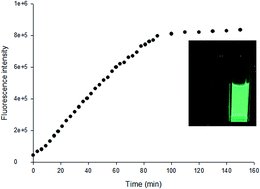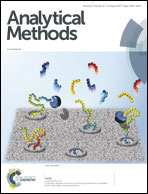A novel two-photon fluorescent probe for the selective detection of hydrogen peroxide based on a naphthalene derivative†
Abstract
In this study, we report a novel two-photon fluorescent probe for monitoring hydrogen peroxide. Probe 1 consists of a naphthalene backbone and a boric acid ester which was used as a H2O2 reporter. The reaction of probe 1 with H2O2 triggers the cleavage of a boronate-based protecting group, and as a result, restores the fluorescence of compound 2. The probe can be applied to the quantification of hydrogen peroxide with a linear range from 1.0 × 10−6 to 2.5 × 10−4 mol L−1. The detection limit of probe 1 toward H2O2 was estimated to be 0.7 μM. Furthermore, probe 1 was found to have a much higher selectivity for H2O2 than other reactive oxygen species and successfully applied to cell imaging of hydrogen peroxide using two-photon microscopy in living cells. The superior properties of the probe made it highly promising for use in chemical and biological applications.



 Please wait while we load your content...
Please wait while we load your content...